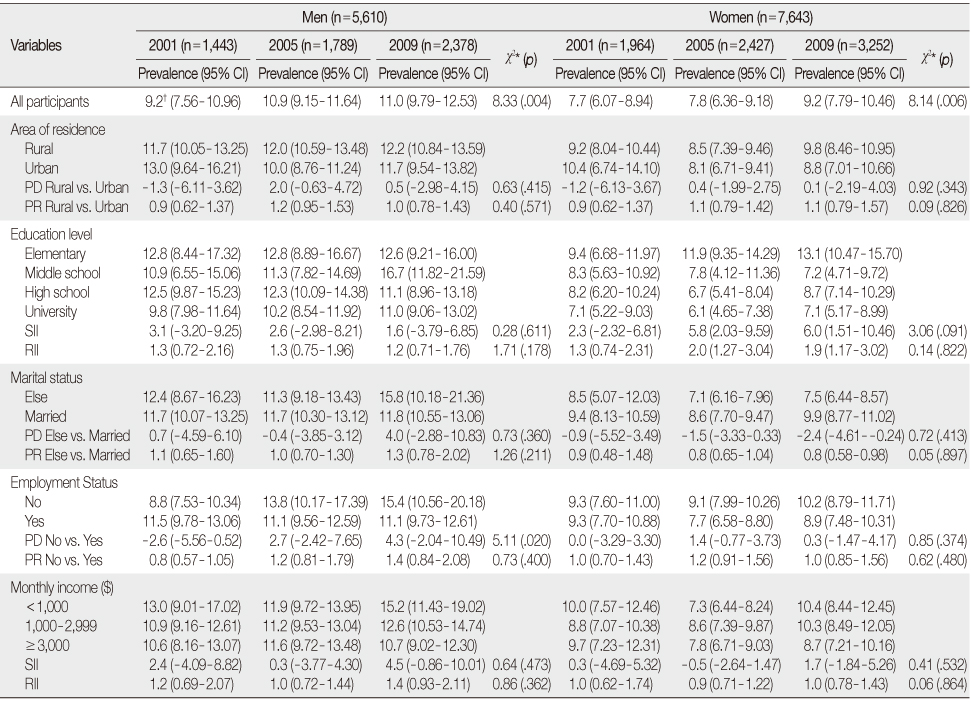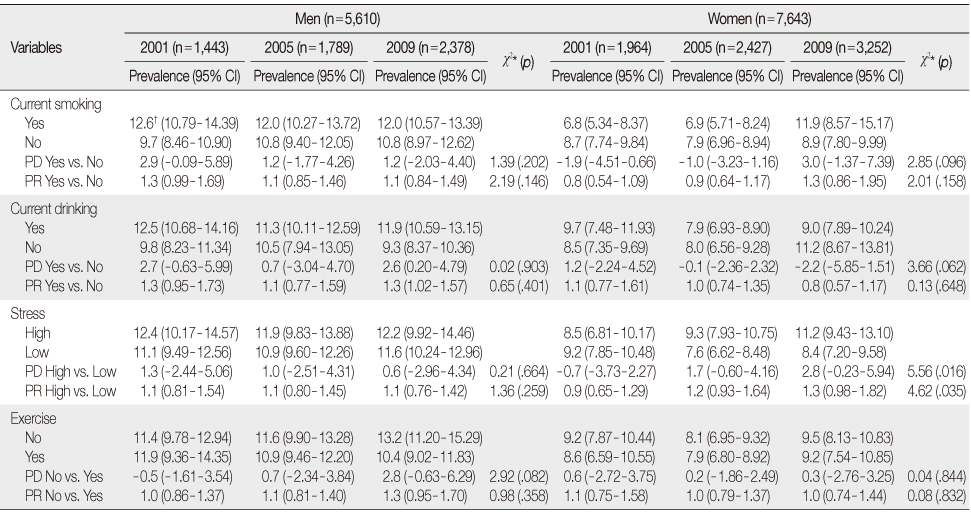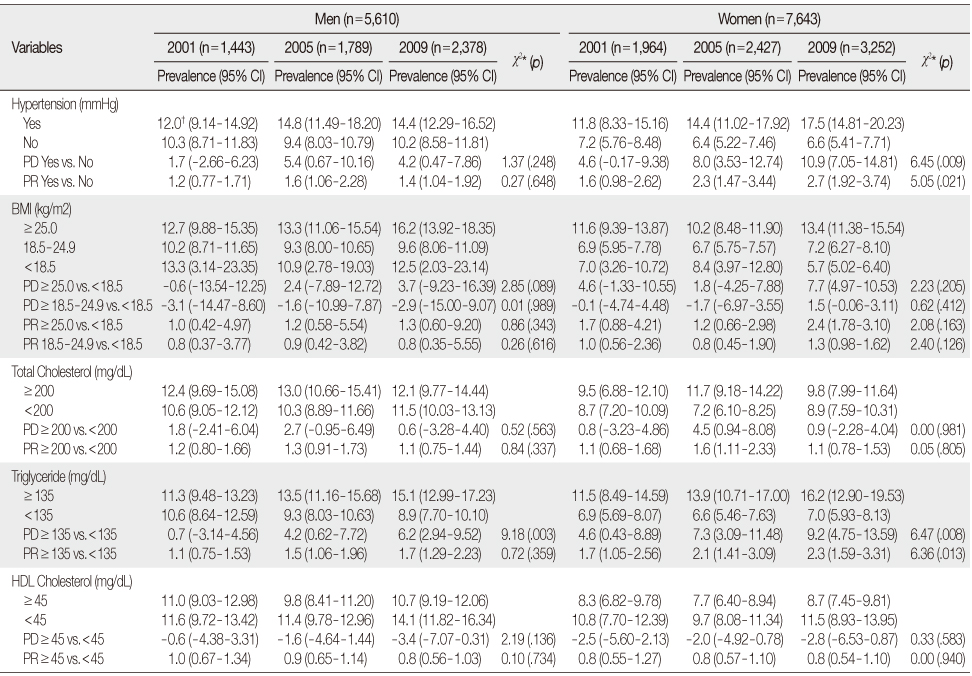Articles
- Page Path
- HOME > J Korean Acad Nurs > Volume 44(6); 2014 > Article
-
Original Article
- Trend Analysis in the Prevalence of Type 2 Diabetes According to Risk Factors among Korean Adults: Based on the 2001~2009 Korean National Health and Nutrition Examination Survey Data
- Young-Ju Kim, Myoung-Nam Lim, Dong-Suk Lee
-
Journal of Korean Academy of Nursing 2014;44(6):743-750.
DOI: https://doi.org/10.4040/jkan.2014.44.6.743
Published online: December 31, 2014
1Department of Statistics, Kangwon National University, Chuncheon, Korea.
2Regional Center for Respiratory Disease, Kangwon National University Hospital, Chuncheon, Korea.
3Department of Nursing, Kangwon National University, Chuncheon, Korea.
- Address reprint requests to: Lee, Dong-Suk. Department of Nursing, Kangwon National University, 1 Gangwondaehak-gil, Chuncheon 200-701, Korea. Tel: +82-33-250-8887, Fax: +82-33-253-5636, ds1119@kangwon.ac.kr
© 2014 Korean Society of Nursing Science
This is an Open Access article distributed under the terms of the Creative Commons Attribution NoDerivs License. (http://creativecommons.org/licenses/by-nd/4.0/) If the original work is properly cited and retained without any modification or reproduction, it can be used and re-distributed in any format and medium.
Abstract
-
Purpose
- The objective of this study was to provide a trend analysis of the prevalence of diabetes relative to the socioeconomic, lifestyle, and physiologic risk factors among Korean adults aged over 30 years for a 10-year period using data from the Korean National Health and Nutrition Examination Survey.
-
Methods
- Prevalence difference and the slope index of inequality were calculated for each risk factors using binomial regression by considering the repeated cross-sectional features of the data. The prevalence ratio and the relative index of inequality were calculated using log-binomial regression. Linear trend tests were performed using SAS 9.2.
-
Results
- Crude prevalence of diabetes increased over the 10-year period, and was higher for men than for women. It was very high for adults 60 years or over, consistently increasing over time. The prevalence among unemployed men, women with higher level of stress, women with hypertension, and adults with serum triglyceride levels over 135 mg/dL increased over the 10-year period in comparison with the respective control group.
-
Conclusion
- Considering the rapid economic development and associated lifestyle changes in Korea, action should be taken to control the prevalence of diabetes by both preventing and consistently monitoring these identified risk factors using a public-health approach.
INTRODUCTION
METHODS
RESULTS
Discussion
CONCLUSION
- 1. Gupta R, Kumar P. Global diabetes landscape-type 2 diabetes mellitus in South Asia: Epidemiology, risk factors, and control. Insulin. 2008;3(2):78–94. http://dx.doi.org/10.1016/S1557-0843(08)80019-XArticle
- 2. Statistics Korea. 2011 cause of death[Internet]. Daejeon, Author. 2012;cited 2012 September 30. Available from: http://kostat.go.kr/portal/korea/kor_nw/2/1/index.board?bmode=read&aSeq=260046
- 3. Park SW, Kim DJ, Min KW, Baik SH, Choi KM, Park IB, et al. Current status of diabetes management in Korea using national health insurance database. J Korean Diabetes Assoc. 2007;31(4):362–367. http://dx.doi.org/10.4093/jkda.2007.31.4.362Article
- 4. Ministry of Health & Welfare and Family Affairs, Korea Center for Disease Control & Prevention. Korea health statistics 2005: Korea national health and nutrition examination survey (KNHANES III). Seoul: Korea Center for Disease Control & Prevention; 2006.
- 5. Kim SG, Choi DS. The present state of diabetes mellitus in Korea. J Korean Med Assoc. 2008;51(9):791–798. http://dx.doi.org/10.5124/jkma.2008.51.9.791Article
- 6. Imkampe AK, Gulliford MC. Increasing socio-economic inequality in type 2 diabetes prevalence-repeated cross-sectional surveys in England 1994-2006. Eur J Public Health. 2011;21(4):484–490. http://dx.doi.org/10.1093/eurpub/ckq106ArticlePubMed
- 7. Krishnan S, Cozier YC, Rosenberg L, Palmer JR. Socioeconomic status and incidence of type 2 diabetes: Results from the black women's health study. Am J Epidemiol. 2010;171(5):564–570. http://dx.doi.org/10.1093/aje/kwp443ArticlePubMedPMC
- 8. Zisser H, Sueyoshi M, Krigstein K, Szigiato A, Riddell MC. Advances in exercise, physical activity and diabetes mellitus. Int J Clin Pract Suppl. 2012;66:Suppl 175. 62–71. http://dx.doi.org/10.1111/j.1742-1241.2011.02856.xArticle
- 9. Norberg M, Stenlund H, Lindahl B, Andersson C, Eriksson JW, Weinehall L. Work stress and low emotional support is associated with increased risk of future type 2 diabetes in women. Diabetes Res Clin Pract. 2007;76(3):368–377. http://dx.doi.org/10.1016/j.diabres.2006.09.002ArticlePubMed
- 10. Kim DH, Ahn YO, Park SW, Choi MG, Kim DS, Lee MS, et al. Incidence and risk factors for diabetes mellitus in Korean middle-aged men: Seoul cohort DM follow-up study. Korean J Prev Med. 1999;32(4):526–537.
- 11. Perry IJ, Wannamethee SG, Walker MK, Thomson AG, Whincup PH, Shaper AG. Prospective study of risk factors for development of noninsulin dependent diabetes in middle aged British men. BMJ. 1995;310(6979):560–564.ArticlePubMedPMC
- 12. Dotevall A, Johansson S, Wilhelmsen L, Rosengren A. Increased levels of triglycerides, BMI and blood pressure and low physical activity increase the risk of diabetes in Swedish women. A prospective 18-year follow-up of the BEDA study. Diabet Med. 2004;21(6):615–622. http://dx.doi.org/10.1111/j.1464-5491.2004.01189.xArticlePubMed
- 13. Lee JW, Brancati FL, Yeh HC. Trends in the prevalence of type 2 diabetes in Asians versus whites: Results from the United States national health interview survey, 1997-2008. Diabetes Care. 2011;34(2):353–357. http://dx.doi.org/10.2337/dc10-0746PubMedPMC
- 14. Mokdad AH, Ford ES, Bowman BA, Nelson DE, Engelgau MM, Vinicor F, et al. Diabetes trends in the U.S.: 1990-1998. Diabetes Care. 2000;23(9):1278–1283.ArticlePubMedPDF
- 15. Heidemann C, Kroll L, Icks A, Lampert T, Scheidt-Nave C. Prevalence of known diabetes in German adults aged 25-69 years: Results from national health surveys over 15 years. Diabet Med. 2009;26(6):655–658. http://dx.doi.org/10.1111/j.1464-5491.2009.02739.xArticlePubMed
- 16. Hamer M, Kengne AP, Batty GD, Cooke D, Stamatakis E. Temporal trends in diabetes prevalence and key diabetes risk factors in Scotland, 2003-2008. Diabet Med. 2011;28(5):595–598.ArticlePubMed
- 17. Ministry of Health & Welfare, Korea Centers for Disease Control & Prevention. Korea health statistics 2009: Korea national health and nutrition examination survey (KNHANES IV-3). Seoul: Ministry of Health & Welfare; 2010.
- 18. Yoo S, Cho HJ, Khang YH. General and abdominal obesity in South Korea, 1998-2007: Gender and socioeconomic differences. Prev Med. 2010;51(6):460–465. http://dx.doi.org/10.1016/j.ypmed.2010.10.004ArticlePubMed
- 19. Khang YH, Yun SC, Lynch JW. Monitoring trends in socioeconomic health inequalities: It matters how you measure. BMC Public Health. 2008;8:66. http://dx.doi.org/10.1186/1471-2458-8-66ArticlePubMedPMCPDF
- 20. Ernstsen L, Strand BH, Nilsen SM, Espnes GA, Krokstad S. Trends in absolute and relative educational inequalities in four modifiable ischaemic heart disease risk factors: Repeated cross-sectional surveys from the Nord-trondelag health study (HUNT) 1984-2008. BMC Public Health. 2012;12:266. http://dx.doi.org/10.1186/1471-2458-12-266PubMedPMC
- 21. Ministry of Health & Welfare, Korea Centers for Disease Control & Prevention. Korea health statistics 2011: Korea national health and nutrition examination survey (KNHANES V-2)[Internet]. Seoul: Ministry of Health & Welfare; 2012.
- 22. International Diabetes Federation. Diabetes atlas. 5th ed. Brussels, BE: Author; 2011.
- 23. Diamond J. The double puzzle of diabetes. Nature. 2003;423(6940):599–602. http://dx.doi.org/10.1038/423599aArticlePubMedPDF
- 24. Statistics Korea. Elderly statistics 2010. Daejeon: Author; 2010.
- 25. Wong K, Glovaci D, Malik S, Franklin SS, Wygant G, Iloeje U, et al. Comparison of demographic factors and cardiovascular risk factor control among U.S. adults with type 2 diabetes by insulin treatment classification. J Diabetes Complications. 2012;26(3):169–174. http://dx.doi.org/10.1016/j.jdiacomp.2012.03.006ArticlePubMedPMC
- 26. Franzini L, Ardigò D, Cavalot F, Miccoli R, Rivellese AA, Trovati M, et al. Women show worse control of type 2 diabetes and cardiovascular disease risk factors than men: Results from the MIND.IT study group of the Italian society of diabetology. Nutr Metab Cardiovasc Dis. 2013;23(3):235–241. http://dx.doi.org/10.1016/j.numecd.2011.12.003ArticlePubMed
- 27. Go MJ. Establishing a prediction model for type 2 diabetes risk using the epidemiological and genetic risk factors. Public Health Wkly Rep. 2011;4(34):605–608.
- 28. Ku BJ. Source of diabetes insulin resistance. Seoul: Nutradex; 2001.
- 29. Ma RC, Chan JC. Type 2 diabetes in East Asians: Similarities and differences with populations in Europe and the United States. Ann N Y Acad Sci. 2013;1281:64–91. http://dx.doi.org/10.1111/nyas.12098ArticlePubMedPMCPDF
- 30. Chan JC, Malik V, Jia W, Kadowaki T, Yajnik CS, Yoon KH, et al. Diabetes in Asia: Epidemiology, risk factors, and pathophysiology. JAMA. 2009;301(20):2129–2140. http://dx.doi.org/10.1001/jama.2009.726ArticlePubMed
REFERENCES


Figure & Data
REFERENCES
Citations

- Analysis of an Association between Preterm Birth and Parental Educational Level in Japan Using National Data
Tasuku Okui
Children.2023; 10(2): 342. CrossRef - Trends in Diabetes Prevalence, Awareness, Treatment and Control in Yangon Region, Myanmar, Between 2004 and 2014, Two Cross-Sectional Studies
Wai Phyo Aung, Espen Bjertness, Aung Soe Htet, Hein Stigum, Marte Karoline Råberg Kjøllesdal
International Journal of Environmental Research and Public Health.2019; 16(18): 3461. CrossRef - Factors affecting glycated hemoglobin(HbA1c) checkup of diabetic patients by gender: Using the community health survey
Yun-Jeong Kim, Byung-Deog Hwang
Korean Journal of Health Education and Promotion.2019; 36(5): 63. CrossRef - Trends in diabetes prevalence among Korean adults based on Korean National Health and Nutrition Examination Surveys III–VI
Jae-woo Lee, Hee-Taik Kang, Hyoung-Ji Lim, Byoungjin Park
Diabetes Research and Clinical Practice.2018; 138: 57. CrossRef - Baseline Cardiovascular Characteristics of Adult Patients with Chronic Kidney Disease from the KoreaN Cohort Study for Outcomes in Patients With Chronic Kidney Disease (KNOW-CKD)
Hyoungnae Kim, Tae-Hyun Yoo, Kyu Hun Choi, Kook-Hwan Oh, Joongyub Lee, Soo Wan Kim, Tae Hee Kim, Suah Sung, Seung Hyeok Han
Journal of Korean Medical Science.2017; 32(2): 231. CrossRef - Secular trends in the prevalence of type 2 diabetes in adults in China from 1995 to 2014: A meta‐analysis
Chengyi Han, Ming Zhang, Xinping Luo, Chongjian Wang, Lei Yin, Chao Pang, Tianping Feng, Yongcheng Ren, Bingyuan Wang, Lu Zhang, Linlin Li, Xiangyu Yang, Hongyan Zhang, Yang Zhao, Junmei Zhou, Zhihui Xie, Jingzhi Zhao, Dongsheng Hu
Journal of Diabetes.2017; 9(5): 450. CrossRef - Utilities for Type 2 Diabetes Treatment-Related Attributes in a South Korean and Taiwanese Population
Narayan Rajan, Kristina S. Boye, Meaghan Gibbs, Yoon Ji Lee, Peter Davey, Mark Ball, Steve M. Babineaux
Value in Health Regional Issues.2016; 9: 67. CrossRef - Awareness, treatment and control of type 2 diabetes among Chinese elderly and its changing trend for past decade
Miao Liu, Jianhua Wang, Yao He, Bin Jiang, Lei Wu, Yiyan Wang, Zhang Di, Jing Zeng
BMC Public Health.2016;[Epub] CrossRef - Prevalence and Risk Factors of Type 2 Diabetes According to Gender among Korean Employees
Sang-A Kim, Woong-Sub Park, Su Jeong Yu, Young Ran Chae, Donghee Choi
Journal of the Korea Academia-Industrial cooperation Society.2015; 16(11): 7589. CrossRef - Association of Family Composition and Metabolic Syndrome in Korean Adults Aged over 45 Years Old
Young-Ju Kim
Asian Nursing Research.2015; 9(4): 349. CrossRef
Crude Prevalence of Type 2 Diabetes by Survey Year and Gender (N=13,253)
*Statistic for Cochran-armitage trend test; †The prevalence measurement unit is the percentage (%).
Age-adjusted Prevalence of Type 2 Diabetes according to Socioeconomic Factors by Survey Year and Gender (N=13,253)
*Chi-square statistic for linear trend test; †The prevalence measurement unit is the percentage (%); CI=Confidence intervals; PD=Prevalence difference; PR=Prevalence ratio; SII=Slope index of inequality; RII=Relative index of inequality.
Age-adjusted Prevalence of Type 2 Diabetes according to Lifestyle Factors by Survey Year and Gender (N=13,253)
*Chi-square statistic for linear trend test; †The prevalence measurement unit is the percentage (%); CI=Confidence intervals; PD=Prevalence difference; PR=Prevalence ratio.
Age-adjusted Prevalence of Type 2 Diabetes according to Physiologic Factors by Survey Year and Gender (N=13,253)
*Chi-square statistic for linear trend test; †The prevalence measurement unit is the percentage (%); CI=Confidence intervals; PD=Prevalence difference; PR=Prevalence ratio; BMI=Body mass index; HDL cholesterol=High density lipoprotein cholesterol.
*Statistic for Cochran-armitage trend test; †The prevalence measurement unit is the percentage (%).
*Chi-square statistic for linear trend test; †The prevalence measurement unit is the percentage (%); CI=Confidence intervals; PD=Prevalence difference; PR=Prevalence ratio; SII=Slope index of inequality; RII=Relative index of inequality.
*Chi-square statistic for linear trend test; †The prevalence measurement unit is the percentage (%); CI=Confidence intervals; PD=Prevalence difference; PR=Prevalence ratio.
*Chi-square statistic for linear trend test; †The prevalence measurement unit is the percentage (%); CI=Confidence intervals; PD=Prevalence difference; PR=Prevalence ratio; BMI=Body mass index; HDL cholesterol=High density lipoprotein cholesterol.
 KSNS
KSNS
 E-SUBMISSION
E-SUBMISSION


 Cite
Cite

